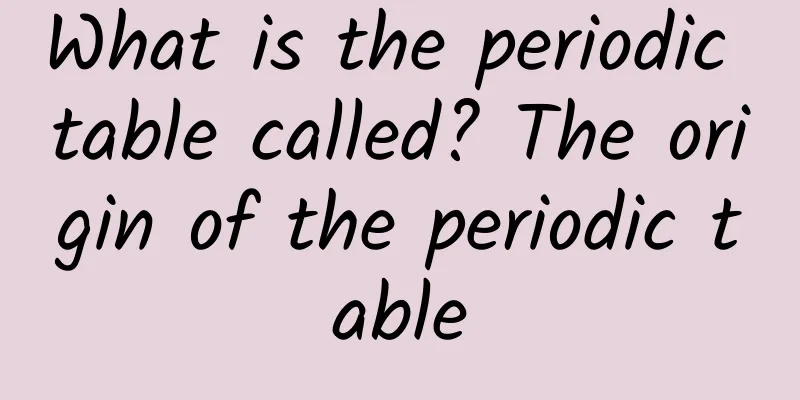What is the periodic table called? The origin of the periodic table

|
The position of elements in the periodic table not only reflects the atomic structure of the elements, but also shows the law of gradual change of the properties of the elements and the internal connection between the elements. It constitutes a complete system and is called one of the important milestones in the development of chemistry. Let's take a closer look at what the periodic table is called, I hope it will be helpful to you. Contents of this article 1. What is the periodic table called? 2. The origin of the periodic table 3. How many groups are there in the periodic table? 1What is the periodic table called?Period. The periodic table has 7 horizontal rows. The vertical rows of the periodic table are called groups, and the arrangement is based on the number of electron shells and the number of outermost electrons. The number of electron shells = the number of periods. The main group number = the number of outermost electrons. Chemical elements are a general term for a class of atoms with the same nuclear charge number (the number of protons in the nucleus). From a philosophical perspective, elements are the result of a qualitative change caused by a quantitative change in the number of electrons in an atom. 2Origin of the periodic tableThe periodic table of modern chemistry was first created by Russian scientist Mendeleev in 1869. He arranged the 63 elements known at that time in the form of a table according to their relative atomic mass, and placed elements with similar chemical properties in the same column, making the prototype of the periodic table. After many years of revision, it became the modern periodic table. In the periodic table, elements are arranged according to their atomic order, with the smallest element at the beginning. A row in the table is called a period, and a column is called a group. The atomic radius decreases from left to right and increases from top to bottom. Using the periodic table, Mendeleev successfully predicted the properties of elements that had not yet been discovered (gallium, scandium, germanium). In 1913, British scientist Moser used cathode rays to hit metals to produce X-rays and found that the larger the atomic number, the higher the frequency of the X-rays. Therefore, he believed that the positive charge of the nucleus determined the chemical properties of the elements, and arranged the elements according to the positive charge in the nucleus (that is, the number of protons or atomic number). Later, after many years of revisions by many scientists, the contemporary periodic table was formed. Arrange the elements in order from small to large according to their relative atomic mass, and put elements with similar chemical properties in a vertical column. Each element has a serial number, which is exactly equal to the number of protons in the nucleus of the atom of the element. This serial number is called the atomic number. In the periodic table, elements are arranged according to the atomic number of the element, with the smallest one at the front. A row in the table is called a period, and a column is called a family. 3How many groups are there in the periodic table?The periodic table has 16 groups, including 7 main groups, 7 sub-groups, one group 0 and one group VIII. The periodic table of chemical elements is a list of chemical elements in ascending order of nuclear charge. The list is generally rectangular, with spaces in some periods so that elements with similar properties are grouped together, such as alkali metals, alkaline earth metals, halogens, and rare gases. This results in the formation of element divisions in the periodic table, which are divided into seven main groups, seven subgroups, group VIII, and group 0. Because the periodic table can accurately predict the properties of various elements and the relationships between them, it is widely used in chemistry and other scientific fields as a useful framework for analyzing chemical behavior. Main group elements are a classification of elements in chemistry, referring to the elements in the s-block and p-block of the periodic table. Another definition of main group elements is chemical elements whose electron shells are full except for the outermost electron shell. All elements in the periodic table except transition metals, lanthanides, actinides, and noble gases are main group elements. From top to bottom, the atomic number of the same main group elements increases gradually, the number of electron shells increases gradually, the atomic radius increases gradually, the ability to gain electrons decreases gradually, the ability to lose electrons increases gradually, the metallicity of the elements increases gradually, the non-metallicity decreases gradually, and the stability of gaseous hydrides decreases gradually. The ions (including oxygen-containing acid radicals) of the main group elements in aqueous solution are colorless. |
>>: Live broadcast|“Limbs” create a new era of full-process management
Recommend
What exactly is going on with poor follicular development?
Poor follicular development is a very common dise...
Can I eat King Oyster Mushroom during menstruation?
Women are prone to dysmenorrhea during menstruati...
Will heat and dampness in the body affect menstruation?
Dampness and heat in the body will affect the nor...
There is a row of bumps on the inside of the genitals
For female friends, the genitals are very fragile...
What happens if my menstrual period lasts for a long time and I have brown discharge?
Under normal circumstances, menstruation occurs o...
Will having sex in early pregnancy cause deformity?
The pregnancy process is very long. If calculated...
Does not wanting to eat in late pregnancy have any impact? What is the reason for not wanting to eat in late pregnancy?
We all know that in the late pregnancy, pregnant ...
Vaginal contractions during pregnancy
I believe that many expectant mothers will often ...
Sunny Side Up: 2022 Instagram Trend Report
1. Fashion and Beauty Minimalist fashion reigns s...
Can I give my husband breast milk after an abortion?
We know that during pregnancy, women's bodies...
What are the symptoms of breast hyperplasia?
Once breast hyperplasia occurs, the breasts will ...
What to do if the breasts become smaller after weaning
What every mother is most worried about after giv...
What causes difficulty in conceiving?
Some married women have reached childbearing age ...
Will it bleed the first time?
In fact, when women have sex for the first time, ...









